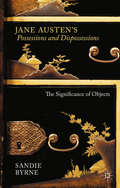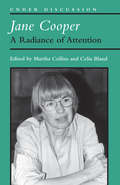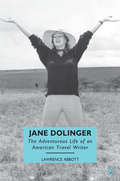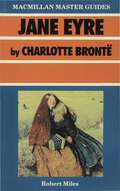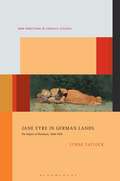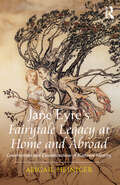- Table View
- List View
Jane Austen’s Philosophy of the Virtues
by S. EmsleyThis book examines Austen's novels in relation to her philosophical and religious context, demonstrating that the combination of the classical and theological traditions of the virtues is central to her work. Austen's heroines learn to confront the fundamental ethical question of how to live their lives. Instead of defining virtue only in the narrow sense of female sexual virtue, Austen opens up questions about a plurality of virtues. In fresh readings of the six completed novels, plus Lady Susan, Emsley shows how Austen's complex imaginative representations of the tensions among the virtues engage with and expand on classical and Christian ethical thought.
Jane Austen's Possessions and Dispossessions: The Significance of Objects
by Sandie ByrneWho owns, who buys, who gives, and who notices objects is always significant in Austen's writing, placing characters socially and characterizing them symbolically. Jane Austen's Possessions and Dispossessions looks at the significance of objects in Austen's major novels, fragments, and juvenilia.
Jane Austen's Universal Truths: Wisdom And Witticisms From Her Writings
by Susan Hart-ByersThe enduring appeal of Jane Austen’s fiction is captured in this pocket-sized collection of quotations taken from her celebrated works.
Jane Barker: Printed Writings 1641–1700: Series II, Part Four, Volume 1 (The Early Modern Englishwoman: A Facsimile Library of Essential Works & Printed Writings, 1641-1700: Series II, Part Four)
by Robert C. EvansJane Barker (1652-1732) is increasingly being recognised as one of the most important English women writers of the late-seventeenth and early-eighteenth centuries. The author of both poems and novels (including novels containing numerous poems), Barker was largely ignored for many years but has recently been the subject of intense interest and investigation. Despite this, no complete, collected edition of Barker's poems has yet appeared, and the present volume is the first reproduction of her important early published volume, Poetical Recreations, to be issued in facsimile as a printed book (rather than on microfilm). Jane Barker's life was rich in incident. Her early poetry was enthusiastically advocated by the male students at St. John's College, Cambridge. A persecuted Catholic and a subsequent longtime exiled supporter of the Jacobite cause in France following the 'Bloodless Revolution', she was also physically disabled and without great financial means, in part because she never married. Almost certainly her decision to begin publishing novels was motivated, on some level, by financial need. By the time she died, in March 1732, at the age of seventy-nine, she had lived a life that had been long, eventful, and accomplished, but by no means easy.
Jane Barker: Printed Writings 1641–1700: Series II, Part Four, Volume 1 (The Early Modern Englishwoman: A Facsimile Library of Essential Works & Printed Writings, 1641-1700: Series II, Part Four)
by Robert C. EvansJane Barker (1652-1732) is increasingly being recognised as one of the most important English women writers of the late-seventeenth and early-eighteenth centuries. The author of both poems and novels (including novels containing numerous poems), Barker was largely ignored for many years but has recently been the subject of intense interest and investigation. Despite this, no complete, collected edition of Barker's poems has yet appeared, and the present volume is the first reproduction of her important early published volume, Poetical Recreations, to be issued in facsimile as a printed book (rather than on microfilm). Jane Barker's life was rich in incident. Her early poetry was enthusiastically advocated by the male students at St. John's College, Cambridge. A persecuted Catholic and a subsequent longtime exiled supporter of the Jacobite cause in France following the 'Bloodless Revolution', she was also physically disabled and without great financial means, in part because she never married. Almost certainly her decision to begin publishing novels was motivated, on some level, by financial need. By the time she died, in March 1732, at the age of seventy-nine, she had lived a life that had been long, eventful, and accomplished, but by no means easy.
Jane Carlyle: Newly Selected Letters (The Nineteenth Century Series)
by Kenneth J. FieldingThis new selection of the letters of Jane Welsh Carlyle presents a complete view of a remarkable Victorian woman, with a wide circle of friends, who enjoyed the company of distinguished thinkers, writers, politicians, feminists, eccentrics and radicals. This edition draws on many remarkable letters and papers not published before, in which she created a memorable epistolary voice - shrewd, vigorous, ironic, observant, humorous and passionate. Previous selections have often tamely followed the semi-mythical version of her life first given by Carlyle’s biographer, James Anthony Froude, showing her as the victimized angel in distress. This new selection gives a rounded picture of her complex character, showing her as a tormented yet forceful woman who was a strong personality in her own right. She now emerges as a self-conscious artist, adept at constructing images of herself that were designed to appeal to her particular correspondents. The account is written with close attention to Jane Carlyle's long-running jealousy of Lady Harriet Ashburton; and fresh letters include many to her mother and her vital response to her passionate lover or admirer Charlotte Cushman. Each letter is a tightly controlled performance, which justifies Thomas Carlyle’s belief that her letters equal and surpass whatever of best I know to exist in that kind.
Jane Carlyle: Newly Selected Letters (The Nineteenth Century Series)
by Kenneth J. FieldingThis new selection of the letters of Jane Welsh Carlyle presents a complete view of a remarkable Victorian woman, with a wide circle of friends, who enjoyed the company of distinguished thinkers, writers, politicians, feminists, eccentrics and radicals. This edition draws on many remarkable letters and papers not published before, in which she created a memorable epistolary voice - shrewd, vigorous, ironic, observant, humorous and passionate. Previous selections have often tamely followed the semi-mythical version of her life first given by Carlyle’s biographer, James Anthony Froude, showing her as the victimized angel in distress. This new selection gives a rounded picture of her complex character, showing her as a tormented yet forceful woman who was a strong personality in her own right. She now emerges as a self-conscious artist, adept at constructing images of herself that were designed to appeal to her particular correspondents. The account is written with close attention to Jane Carlyle's long-running jealousy of Lady Harriet Ashburton; and fresh letters include many to her mother and her vital response to her passionate lover or admirer Charlotte Cushman. Each letter is a tightly controlled performance, which justifies Thomas Carlyle’s belief that her letters equal and surpass whatever of best I know to exist in that kind.
Jane Cooper: A Radiance of Attention (Under Discussion)
by Martha Collins Celia BlandThough she published only five volumes of poetry over the course of her career, Jane Cooper (1924–2007) was deeply admired by her contemporaries, and teaching at Sarah Lawrence College for nearly forty years, she served as a mentor to many aspiring poets. Her elegant, honest, and emotionally and formally precise poems, often addressing the challenges of women’s lives—especially the lives of women in the arts—continue to resonate with a new generation of readers. Martha Collins and Celia Bland bring together several decades’ worth of essential writing on Cooper’s poetry. While some pieces offer close examination of Cooper’s process or thoughtful consideration of the craft of a single poem, the volume also features reviews of her collections, including a previously unpublished piece on her first book, The Weather of Six Mornings (1969), by James Wright, a lifelong champion of her work. Marie Howe, Jan Heller Levi, and Thomas Lux, among others, share personal remembrances of Cooper as a teacher, colleague, and inspiration. L. R. Berger’s moving tribute to Cooper’s final days closes the volume. This book has much to offer for both readers who already love Cooper’s work and new readers, especially among younger poets, just discovering her enduring poems.
Jane Dolinger: The Adventurous Life of an American Travel Writer
by L. AbbottFor almost forty years, Jane Dolinger traveled the world and wrote about her adventures, from the Amazon jungle to the sands of the Sahara. She produced eight books and more than a thousand articles between 1955 and 1995, and she also earned a reputation as a glamorous celebrity and model. Jane Dolinger was an anomaly in her time, a dynamic and attractive woman with an impressive literary talent, a woman who lived and documented a most unconventional and inspirational life. Sometimes controversial but always outstanding, Jane was a pioneer among women and writers. Here for the first time, her life and work are studied in a thoroughly researched yet entertaining literary biography.
Jane Eyre
by Caroline WoolfePREPARE FOR SUCCESS WITH YORK NOTES WORKBOOKS! York Notes for GCSE Workbooks offer a wide range of write-in tasks and exercises to boost your knowledge of the text and help you practise for the exam: * Learn: Tasks and answers on every area of the text, from Plot and Action and Characters to Key Contexts, Themes, Language and Structure, will help to enhance your learning and take your revision further. * Practise: With exercises on spelling, punctuation and grammar, sample paragraphs and exam-style questions, you can practise and perfect all the key skills you need to write top-quality answers. * Test yourself: Use the quick tests and longer questions to put your knowledge to the test. Monitor your progress at every stage and stay on track for success! Did you know? York Notes for GCSE Workbooks are the perfect partner to the bestselling York Notes for GCSE Study Guides. Use them together and prepare for success!
Jane Eyre by Charlotte Brontë (Bloomsbury Master Guides)
by Robert MilesThis ebook is now available from Bloomsbury Academic. Bloomsbury Academic publish acclaimed resources for undergraduate and postgraduate courses across a broad range of subjects including Art & Visual Culture, Biblical Studies, Business & Management, Drama & Performance Studies, Economics, Education, Film & Media, History, Linguistics, Literary Studies, Philosophy, Politics & International Relations, Religious Studies, Social Work & Social Welfare, Study Skills and Theology. Visit bloomsbury.com for more information.
Jane Eyre in German Lands: The Import of Romance, 1848–1918 (New Directions in German Studies)
by Lynne TatlockLynne Tatlock examines the transmission, diffusion, and literary survival of Jane Eyre in the German-speaking territories and the significance and effects thereof, 1848-1918. Engaging with scholarship on the romance novel, she presents an historical case study of the generative power and protean nature of Brontë's new romance narrative in German translation, adaptation, and imitation as it involved multiple agents, from writers and playwrights to readers, publishers, illustrators, reviewers, editors, adaptors, and translators. Jane Eyre in German Lands traces the ramifications in the paths of transfer that testify to widespread creative investment in romance as new ideas of women's freedom and equality topped the horizon and sought a home, especially in the middle classes. As Tatlock outlines, the multiple German instantiations of Brontë's novel-four translations, three abridgments, three adaptations for general readers, nine adaptations for younger readers, plays, farces, and particularly the fiction of the popular German writer E. Marlitt and its many adaptations-evince a struggle over its meaning and promise. Yet precisely this multiplicity (repetition, redundancy, and proliferation) combined with the romance narrative's intrinsic appeal in the decades between the March Revolutions and women's franchise enabled the cultural diffusion, impact, and long-term survival of Jane Eyre as German reading. Though its focus on the circulation of texts across linguistic boundaries and intertwined literary markets and reading cultures, Jane Eyre in German Lands unsettles the national paradigm of literary history and makes a case for a fuller and inclusive account of the German literary field.
Jane Eyre in German Lands: The Import of Romance, 1848–1918 (New Directions in German Studies)
by Lynne TatlockLynne Tatlock examines the transmission, diffusion, and literary survival of Jane Eyre in the German-speaking territories and the significance and effects thereof, 1848-1918. Engaging with scholarship on the romance novel, she presents an historical case study of the generative power and protean nature of Brontë's new romance narrative in German translation, adaptation, and imitation as it involved multiple agents, from writers and playwrights to readers, publishers, illustrators, reviewers, editors, adaptors, and translators. Jane Eyre in German Lands traces the ramifications in the paths of transfer that testify to widespread creative investment in romance as new ideas of women's freedom and equality topped the horizon and sought a home, especially in the middle classes. As Tatlock outlines, the multiple German instantiations of Brontë's novel-four translations, three abridgments, three adaptations for general readers, nine adaptations for younger readers, plays, farces, and particularly the fiction of the popular German writer E. Marlitt and its many adaptations-evince a struggle over its meaning and promise. Yet precisely this multiplicity (repetition, redundancy, and proliferation) combined with the romance narrative's intrinsic appeal in the decades between the March Revolutions and women's franchise enabled the cultural diffusion, impact, and long-term survival of Jane Eyre as German reading. Though its focus on the circulation of texts across linguistic boundaries and intertwined literary markets and reading cultures, Jane Eyre in German Lands unsettles the national paradigm of literary history and makes a case for a fuller and inclusive account of the German literary field.
Jane Eyre on Stage, 1848–1898: An Illustrated Edition of Eight Plays with Contextual Notes (The Nineteenth Century Series)
by Patsy StonemanCharlotte Brontë's Jane Eyre was published in October, 1847, and within three months a version was on stage in London. By 1900, at least eight different stage versions had appeared in England, America and continental Europe. For the first time, all eight plays are available in Patsy Stoneman's critical edition, richly illustrated by facsimile reproductions of manuscripts, unique Victorian playbills, contemporary etchings of theatres, and portraits of playwrights and actors. Stoneman's introduction places the plays' bizarre innovations in the context of theatre history and of contemporary debates on class and gender, while each edited play-text is accompanied by detailed notes, based on original research, on the playwright, theatre(s) and performances, and contemporary reception. Most of these plays existed only in manuscript, and were quickly forgotten, yet they make fascinating reading. Nineteenth-century playwrights had no reverence for a text we regard as canonical, but added to, deleted from and twisted Charlotte Brontë's story to suit their own purposes. One play has a cast of comic servants who follow Jane from Lowood to Thornfield. In another, the madwoman is revealed as the sister-in-law of a blameless Rochester. A third has Blanche Ingram reduced to a fallen woman, seduced and abandoned by John Reed. Jane Eyre on Stage will appeal to readers interested in literary and theatrical history, cultural studies, and the intriguing afterlives of famous books.
Jane Eyre on Stage, 1848–1898: An Illustrated Edition of Eight Plays with Contextual Notes (The Nineteenth Century Series)
by Patsy StonemanCharlotte Brontë's Jane Eyre was published in October, 1847, and within three months a version was on stage in London. By 1900, at least eight different stage versions had appeared in England, America and continental Europe. For the first time, all eight plays are available in Patsy Stoneman's critical edition, richly illustrated by facsimile reproductions of manuscripts, unique Victorian playbills, contemporary etchings of theatres, and portraits of playwrights and actors. Stoneman's introduction places the plays' bizarre innovations in the context of theatre history and of contemporary debates on class and gender, while each edited play-text is accompanied by detailed notes, based on original research, on the playwright, theatre(s) and performances, and contemporary reception. Most of these plays existed only in manuscript, and were quickly forgotten, yet they make fascinating reading. Nineteenth-century playwrights had no reverence for a text we regard as canonical, but added to, deleted from and twisted Charlotte Brontë's story to suit their own purposes. One play has a cast of comic servants who follow Jane from Lowood to Thornfield. In another, the madwoman is revealed as the sister-in-law of a blameless Rochester. A third has Blanche Ingram reduced to a fallen woman, seduced and abandoned by John Reed. Jane Eyre on Stage will appeal to readers interested in literary and theatrical history, cultural studies, and the intriguing afterlives of famous books.
Jane Eyre's Fairytale Legacy at Home and Abroad: Constructions and Deconstructions of National Identity
by Abigail HeinigerExploring the literary microcosm inspired by Brontë's debut novel, Jane Eyre's Fairytale Legacy at Home and Abroad focuses on the nationalistic stakes of the mythic and fairytale paradigms that were incorporated into the heroic female bildungsroman tradition. Jane Eyre, Abigail Heiniger argues, is a heroic changeling indebted to the regional, pre-Victorian fairy lore Charlotte Brontë heard and read in Haworth, an influence that Brontë repudiates in her last novel, Villette. While this heroic figure inspired a range of female writers on both sides of the Atlantic, Heiniger suggests that the regional aspects of the changeling were especially attractive to North American writers such as Susan Warner and L.M. Montgomery who responded to Jane Eyre as part of the Cinderella tradition. Heiniger contrasts the reactions of these white women writers with that of Hannah Crafts, whose Jane Eyre-influenced The Bondwoman's Narrative rejects the Cinderella model. Instead, Heiniger shows, Crafts creates a heroic female bildungsroman that critiques fairytale narratives from the viewpoint of the obscure, oppressed workers who remain forever outside the tales of wonder produced for middle-class consumption. Heiniger concludes by demonstrating how Brontë's middle-class American readers projected the self-rise ethic onto Jane Eyre, miring the novel in nineteenth-century narratives of American identity formation.
Jane Eyre's Fairytale Legacy at Home and Abroad: Constructions and Deconstructions of National Identity
by Abigail HeinigerExploring the literary microcosm inspired by Brontë's debut novel, Jane Eyre's Fairytale Legacy at Home and Abroad focuses on the nationalistic stakes of the mythic and fairytale paradigms that were incorporated into the heroic female bildungsroman tradition. Jane Eyre, Abigail Heiniger argues, is a heroic changeling indebted to the regional, pre-Victorian fairy lore Charlotte Brontë heard and read in Haworth, an influence that Brontë repudiates in her last novel, Villette. While this heroic figure inspired a range of female writers on both sides of the Atlantic, Heiniger suggests that the regional aspects of the changeling were especially attractive to North American writers such as Susan Warner and L.M. Montgomery who responded to Jane Eyre as part of the Cinderella tradition. Heiniger contrasts the reactions of these white women writers with that of Hannah Crafts, whose Jane Eyre-influenced The Bondwoman's Narrative rejects the Cinderella model. Instead, Heiniger shows, Crafts creates a heroic female bildungsroman that critiques fairytale narratives from the viewpoint of the obscure, oppressed workers who remain forever outside the tales of wonder produced for middle-class consumption. Heiniger concludes by demonstrating how Brontë's middle-class American readers projected the self-rise ethic onto Jane Eyre, miring the novel in nineteenth-century narratives of American identity formation.
Jane Owen: Printed Writings 1500–1640: Series I, Part Two, Volume 9 (The Early Modern Englishwoman: A Facsimile Library of Essential Works & Printed Writings, 1500-1640: Series I, Part Two)
by Dorothy L. LatzFew facts are known about Catholic recusant Jane Owen. The title page of this, her only work, tells us that in 1634 when this volume was published at St Omer, she was already deceased. However, she was necessarily still living after 1617 when the treatise of Bellarmine, which she here partially translates and comments on, De Gemitu Columbae, was first published. It seems likely that she spent most of her life in England but later lived in exile on the Continent, possibly returning regularly to collect alms for poverty stricken English recusants abroad. Her simple prose gives us unique glimpses of social history written by a recusant woman in the first person.
Jane Owen: Printed Writings 1500–1640: Series I, Part Two, Volume 9 (The Early Modern Englishwoman: A Facsimile Library of Essential Works & Printed Writings, 1500-1640: Series I, Part Two)
by Dorothy L. LatzFew facts are known about Catholic recusant Jane Owen. The title page of this, her only work, tells us that in 1634 when this volume was published at St Omer, she was already deceased. However, she was necessarily still living after 1617 when the treatise of Bellarmine, which she here partially translates and comments on, De Gemitu Columbae, was first published. It seems likely that she spent most of her life in England but later lived in exile on the Continent, possibly returning regularly to collect alms for poverty stricken English recusants abroad. Her simple prose gives us unique glimpses of social history written by a recusant woman in the first person.
Janeites: Austen’s Disciples and Devotees
by Deidre LynchOver the last decade, as Jane Austen has moved center-stage in our culture, onto best-seller lists and into movie houses, another figure has slipped into the spotlight alongside her. This is the "Janeite," the zealous reader and fan whose devotion to the novels has been frequently invoked and often derided by the critical establishment. Jane Austen has long been considered part of a great literary tradition, even legitimizing the academic study of novels. However, the Janeite phenomenon has not until now aroused the curiosity of scholars interested in the politics of culture. Rather than lament the fact that Austen today shares the headlines with her readers, the contributors to this collection inquire into why this is the case, ask what Janeites do, and explore the myriad appropriations of Austen--adaptations, reviews, rewritings, and appreciations--that have been produced since her lifetime. The articles move from the nineteenth-century lending library to the modern cineplex and discuss how novelists as diverse as Cooper, Woolf, James, and Kipling have claimed or repudiated their Austenian inheritance. As case studies in reception history, they pose new questions of long-loved novels--as well as new questions about Austen's relation to Englishness, about the boundaries between elite and popular cultures and amateur and professional readerships, and about the cultural work performed by the realist novel and the marriage plot. The contributors are Barbara M. Benedict, Mary A. Favret, Susan Fraiman, William Galperin, Claudia L. Johnson, Deidre Lynch, Mary Ann O'Farrell, Roger Sales, Katie Trumpener, and Clara Tuite.
Janeites: Austen's Disciples and Devotees
by Deidre LynchOver the last decade, as Jane Austen has moved center-stage in our culture, onto best-seller lists and into movie houses, another figure has slipped into the spotlight alongside her. This is the "Janeite," the zealous reader and fan whose devotion to the novels has been frequently invoked and often derided by the critical establishment. Jane Austen has long been considered part of a great literary tradition, even legitimizing the academic study of novels. However, the Janeite phenomenon has not until now aroused the curiosity of scholars interested in the politics of culture. Rather than lament the fact that Austen today shares the headlines with her readers, the contributors to this collection inquire into why this is the case, ask what Janeites do, and explore the myriad appropriations of Austen--adaptations, reviews, rewritings, and appreciations--that have been produced since her lifetime. The articles move from the nineteenth-century lending library to the modern cineplex and discuss how novelists as diverse as Cooper, Woolf, James, and Kipling have claimed or repudiated their Austenian inheritance. As case studies in reception history, they pose new questions of long-loved novels--as well as new questions about Austen's relation to Englishness, about the boundaries between elite and popular cultures and amateur and professional readerships, and about the cultural work performed by the realist novel and the marriage plot. The contributors are Barbara M. Benedict, Mary A. Favret, Susan Fraiman, William Galperin, Claudia L. Johnson, Deidre Lynch, Mary Ann O'Farrell, Roger Sales, Katie Trumpener, and Clara Tuite.
The January–May Marriage in Nineteenth-Century British Literature
by E. GodfreyBy considering the disruptive potential of age disparate marriages in nineteenth-century British literature, Godfrey offers provocative new readings of canonical texts including Don Juan, Jane Eyre, and Bleak House.
Japan and Japonisme in Late Nineteenth Century Literature (Asia, Europe, and Global Connections)
by Naomi Charlotte FukuzawaThis book examines the transnational phenomenon of Japonisme in the exoticist and “autoexoticist” literature of the late nineteenth century.Focusing on the way in which reciprocal processes of transcultural acquisition – by Japan and from Japan – were portrayed in the medium of literature, the book illustrates how literary Japonisme and the wider processes whereby Japan, with its alien exotic culture and unique refined aestheticism, was absorbing Western civilization in its own way in the late nineteenth century at the same time as the phenomenon of Japonisme was occurring in Western fine arts, which were inspired by traditional Japanese artistic practices. Specifically, the book focuses on the literary works of Lafcadio Hearn and Pierre Loti, who travelled from France and America, respectively, to Japan, and Mori Ōgai and Natsume Sōseki, who in turn went, respectively, to Germany and England from Japan.Exploring the eclectic hybridity of Japan’s modernization during the late nineteenth century, this book will appeal to students and scholars of Japanese Studies, Postcolonial Studies and Comparative Literature.
Japan and Japonisme in Late Nineteenth Century Literature (Asia, Europe, and Global Connections)
by Naomi Charlotte FukuzawaThis book examines the transnational phenomenon of Japonisme in the exoticist and “autoexoticist” literature of the late nineteenth century.Focusing on the way in which reciprocal processes of transcultural acquisition – by Japan and from Japan – were portrayed in the medium of literature, the book illustrates how literary Japonisme and the wider processes whereby Japan, with its alien exotic culture and unique refined aestheticism, was absorbing Western civilization in its own way in the late nineteenth century at the same time as the phenomenon of Japonisme was occurring in Western fine arts, which were inspired by traditional Japanese artistic practices. Specifically, the book focuses on the literary works of Lafcadio Hearn and Pierre Loti, who travelled from France and America, respectively, to Japan, and Mori Ōgai and Natsume Sōseki, who in turn went, respectively, to Germany and England from Japan.Exploring the eclectic hybridity of Japan’s modernization during the late nineteenth century, this book will appeal to students and scholars of Japanese Studies, Postcolonial Studies and Comparative Literature.
Japan and the Cosmopolitan Gothic: Specters of Modernity
by M. BlouinJapan is imagined routinely in American discourse as a supernatural entity. Gothic tales from these two cultures have been exchanged, consumed, and adapted. Here, Blouin examines a prevalent tendency within the United States-Japan cultural relationship to project anxiety outward only to find shadowy outlines of the self abroad.

